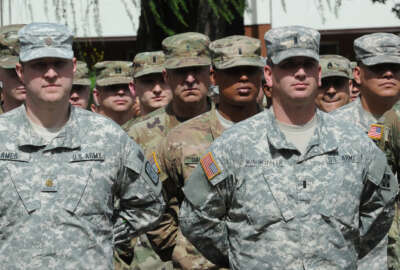Best listening experience is on Chrome, Firefox or Safari. Subscribe to Federal Drive’s daily audio interviews on Apple Podcasts or PodcastOne.
The Defense Department’s nondeployability policy took effect on Oct. 1, but the military services are still hashing out the best way to deal with service members who are unable to deploy for a year or more.
The services and combatant commands are toying with the idea of conditional deployability. It’s the notion that if one service member isn’t able to deploy to one area, such as the Middle East, he or she might be able to deploy to another area that is more suitable — for example, South Korea.
“Even though a service member is nondeployable to U.S. Central Command for a variety of reasons, that individual may still be deployable to U.S. Indo-Pacific Command or other commands,” said Rear Adm. Colin Chinn, the Joint Staff Surgeon, during a speech last Thursday at the Association of Military Surgeons of the United States annual conference in National Harbor, Md. “Therefore should we be labeling that individual nondeployable just because he or she is nondeployable to one combatant command?”
DoD announced its nondeployability policy in February. The policy stated that service members who have been unable to deploy for a year must be cut from the military starting Oct. 1. The announcement, at the time, threatened the jobs of more than a quarter of a million troops. Since then DoD and the military services took measures to get service members back to deployable status. A large number simply needed to get up to date with dental or physical checkups. The number is down to about 126,000 as of Aug. 31.
The definition of deployability is one issue that hung over the policy from the beginning, and the services are still figuring out what nondeployability means for them.
Lt. Gen. Dorothy Hogg, the Air Force surgeon general, said her service is also looking into conditional deployment.
“We have a habit of being very conservative and risk averse. We have somebody in the clinic and we automatically go, ‘nondeployable,’ but that might not be the case,” Hogg said. “What we are looking at is bringing some common sense into the algorithm for when an active duty person comes into the clinic with an injury. We’ll go through a series of steps: is it duty limiting, can they go someplace else? Maybe they aren’t deployed to CENTCOM, but they can go someplace else as opposed to just making them blanketly nondeployable.”
The Army is considering the same option. Sgt. Maj. Michael Gragg, of the Army Medical Service Corps command, told Federal News Network the Army needs to be careful in using its limited human resources.
“There are studies and working groups in place right now to see if an individual is not able to deploy to this area of the world, may still be able to deploy to that area of the world,” Gragg said.
DoD and the services are also changing their own policies to take better care of troops so they stay deployable.
“What we are doing is going to the unit, embedding medics with some high risk operators so we can prevent some of the health related injuries and return them back to duty quicker,” Hogg said.
Navy Surgeon General Vice Adm. Forrest Faison III said his service established a network of chief medical officers at every medical treatment facility.
The Navy’s new policy makes it so only the chief medical officer in conjunction with the commanding officer can deem a sailor nondeployable.
Copyright
© 2024 Federal News Network. All rights reserved. This website is not intended for users located within the European Economic Area.
